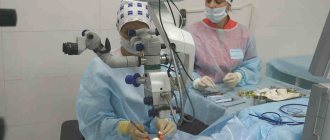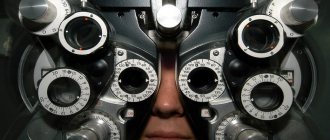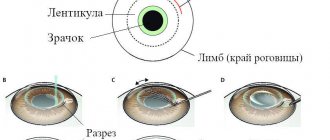Many years of research by scientists prove that the result of laser correction remains stable for life. If a patient’s vision has decreased after laser correction, the cause may be other vision pathologies: diseases of the lens, retina, optic nerve. Also, patients after 45 years of age develop age-related farsightedness, which is a natural process of aging and cannot be prevented. In this case, the patient will need additional correction of presbyopia using glasses or lenses.
Possible complications after laser correction
Complications after laser vision correction are minimized. The intervention is often not perceived as a major operation and in some countries is considered a cosmetic procedure. Modern laser equipment minimizes the human factor and allows you to pre-set personalized parameters for each operation. The absence of general anesthesia and the ease of the rehabilitation period determine the ease of acceptance of the manipulation by the patient and rapid recovery.
In most cases, the operation allows you to achieve all the parameters of visual acuity that were initially planned during preoperative consultations in the clinic. However, complications from microsurgical intervention cannot be completely excluded. No patient can be immune from unforeseen circumstances during or after correction.
The main complications of vision correction using laser beams:
- inflammatory changes;
- increased intraocular pressure;
- changes in the condition of the retina;
- violation of the integrity or configuration of the cornea;
- dry eye syndrome;
- swelling of intraocular structures;
- various visual impairments.
The main expected outcome of the operation is the achievement of high visual acuity and restoration of the functions of the visual system. Therefore, patients expect to feel positive changes immediately after the intervention. However, a number of external or internal factors can lead to unforeseen features - lack of effect or short-term results of manipulation.
The reasons for such consequences may be:
- Changing laser exposure parameters before surgery.
Laser devices are pre-set according to the patient’s individual indicators of initial visual acuity. Changing settings is a rare occurrence, but it is possible that a combination of several technical errors can result in the laser device not functioning properly. - Surgeons' mistakes.
Despite the fact that the influence of the human factor during laser correction is minimized, ophthalmologists carry out part of the intervention with their own hands, and also guide the device during the action of the laser beam. - Individual characteristics of the patient's body.
Additional risk factors, comorbidities, sensitivities, and other unforeseen internal circumstances may also lead to fluctuations in visual acuity. - Violations of recommendations and restrictions.
Patients themselves are often to blame for changes in visual acuity after laser correction.
It is considered a relatively normal situation if vision decreases after laser correction in the evening. Visual perception of objects in low light conditions is complex, and damage to the retina or other ocular structures can negatively affect twilight vision. Usually, after a month, all unpleasant symptoms disappear and night vision is restored.
Also, on the verge of relative contraindications, surgery is considered to be performed at the age of over 50 years, since the natural processes of age-related changes in visual acuity can negatively affect the results of laser correction. Carrying out LKZ does not change the natural processes of formation of farsightedness - presbyopia.
Short-term consequences of correction
After a laser procedure, many patients are bothered by severe itching that occurs as the eye tissue heals. In addition to this symptom, other temporary side effects may occur, taking the form of:
- decreased visual acuity;
- a sensation reminiscent of the presence of a foreign body, “sand” in the eyes;
- redness or swelling of the conjunctiva;
- inflammatory reactions;
- uncontrollable lacrimation;
- increased sensitivity to lighting (photophobia);
- blurring or doubling of visible objects;
- hemorrhages in the structures of the eyeball;
- deterioration of twilight vision.
Such conditions can last for several days or weeks, but tend to disappear spontaneously, without intensive therapeutic measures. Ophthalmologists classify them as a normal reaction of the visual organs to external interference and extremely rarely consider them as a pathology.
According to statistics, every second patient who has undergone laser correction develops keratoconjunctivitis sicca.
With this disorder, discomfort, burning, pain, itching in the eye, and severe redness of the mucous membrane occur. The operated person may see surrounding objects blurry.
Keratoconjunctivitis sicca is caused by minor damage to the tear film that occurs during an ophthalmic procedure. This structure is designed to protect the eyeball from dryness, infection and irritation.
Those most at risk of developing pathology are:
- women during menopause;
- persons who suffered from dry eyes before surgery;
- patients using soft or hard contact lenses who are susceptible to myopia, hypovitaminosis, and thyroid diseases;
- people taking certain medications.
Short-term discomfort is successfully eliminated under the supervision of a doctor. It is possible to get rid of them through the use of ophthalmic medications prescribed to patients immediately after surgery.
Another complication of laser surgery is over- or under-correction. In the first case, there is a transition from minus to plus. Vision usually improves over time. To correct age-related farsightedness, insufficient correction is introduced deliberately.
The situation may become more serious when the patient develops systemic complications. Even if they disappear over time, they can negatively affect the quality of vision in the future. Systemic complications often require surgical treatment. This group of probable consequences of laser correction includes impaired curvature of the cornea, loss of a corneal flap cut by a laser (this happens when an injury occurs in the first postoperative month), and the growth of fibrous epithelial tissue that can expand under the incision of the cornea.
What to do if vision decreases after surgery
The doctor gives detailed instructions and a printed reminder to everyone after laser vision correction surgery. The patient receives guidance for action and clear explanations about the further development of symptoms - how quickly vision will return to normal and how often fluctuations in visual acuity are possible, about which there is no need to worry.
However, you must immediately contact an ophthalmologist if your vision has decreased after laser correction in combination with the following symptoms:
- pain at rest or when trying to examine objects;
- unpleasant sticking of the eyelids or mucous membranes;
- redness of the conjunctiva or sclera;
- feeling of “sand” or foreign objects in the eyes;
- burning;
- lacrimation;
- photophobia;
- halos from brightly lit objects;
- flashing “flies”;
- blurred vision when looking at objects.
It is also important to immediately make an appointment at the first sign of other complications - inflammatory processes, dry eyes, blurred vision, headaches.
Long-term complications
Long-term consequences of the procedure may appear in the coming months or years following the operation. The incidence of such complications on average does not exceed 3%.
The most common long-term consequences of laser vision correction include:
- defective metabolic processes, causing insufficient tissue nutrition, development of dry eye syndrome;
- frequent inflammatory processes in the visual system;
- the occurrence of astigmatism, leading to blurred vision at various distances;
- progressive clouding of the ocular cornea;
- deterioration of visual function in farsighted or nearsighted patients;
- deformation of the cornea, complemented by impaired light transmission and the occurrence of keratectasia (bulging of thinned corneal areas);
- increase in intraocular pressure indicators;
- thinning of the corneal tissue, formation of keratoconus.
When such problems arise, there is a need for detailed ophthalmological diagnostics and appropriate treatment.
Is repeat surgery necessary?
Despite the fact that the need for additional surgical intervention is one of the main reasons for fear and doubt among those undergoing surgery, the list of medical indications for repeated surgery is quite limited.
There is nothing wrong with repeated correction; this is a common practice in patients with an initially high degree of myopia, farsightedness or mixed astigmatism. Also, such stages are carried out to improve already achieved results or unforeseen circumstances after laser treatment.
Main indications for repeated laser vision correction:
- a result that does not suit the patient;
- severe degrees of myopia or farsightedness, when initially we are talking about intervention in several stages;
- deterioration of vision due to non-compliance with preoperative preparation techniques, the course of the operation or the rehabilitation period;
- excessive correction – individual characteristics of the restoration of the cornea;
- persistent manifestations of the halo effect - the appearance of a halo around light sources.
Most often, visual impairment after laser correction is reversible and does not require repeat surgery. Also, some patients have a number of contraindications for repeated microsurgical interventions - thinning of the cornea, scarring of its structures, and other pathologies that appeared after the first operation.
What complications occur most often after surgery?
According to ophthalmologists, the most common side effects after surgery include:
- decreased vision in the dark, as well as in unfavorable weather conditions;
- sensation of a foreign body in the eye, which may persist for several days;
- increased tearfulness, especially on the first day after surgery;
- the occurrence of “dry eye” syndrome due to drying of the upper layer of the cornea after LASIK;
- eye sensitivity to bright light.
Lens replacement surgery
Eye lens surgery may not occur if the required recommendations of the attending physician are not followed. That is, for a complete recovery you need to understand that:
- You can get up only after half an hour after phacoemulsification. You are also allowed to eat if you wish, but the food should not be hot or too hard.
- You are allowed to leave our clinic an hour after the operation, provided, of course, that no illness has arisen during this period of time;
- After a day, the patient must visit a specialist, since the recovery period is as important as the lens replacement surgery itself. Such visits should continue for 10-14 days. The duration depends on the progress of the healing process and the general health of the person.
- It is advisable to sleep for the first week on your side, which is opposite to the operated area, or on your back. Thus, the pressure on the weakened area will be less, therefore, the condition will return to normal faster. You should also not swim during this period of time.
- Wearing sunglasses is mandatory for the first few weeks. They will protect against exposure to ultraviolet rays and the harmful effects of wind and dust.
- Nutrition should be properly balanced, that is, there is no place in the diet for alcohol, soda and excessive amounts of water.
- Visual stress should also be reduced to a minimum, physical stress should also not be present. You are only allowed to lift objects weighing no more than 5 kg.











